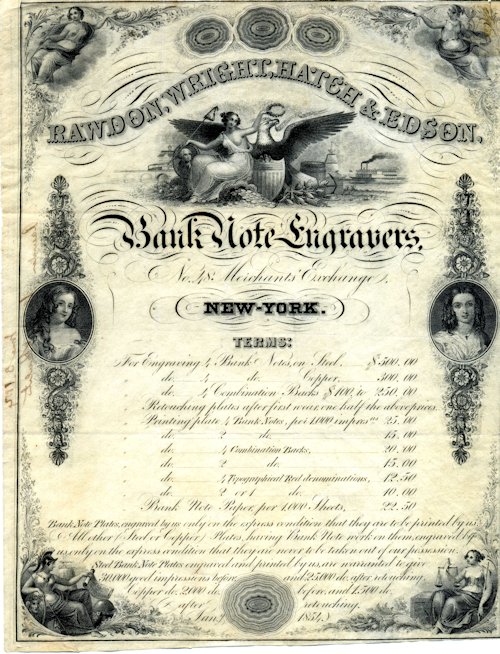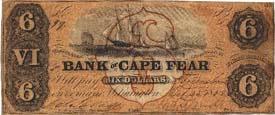|
North Carolina's North Carolina's numismatic history prior to the Civil War is quite rich indeed. North Carolina was the site of the first documented discovery of gold in the newly formed United States in 1799 and largest domestic producer of gold until 1849. It was home to the most successful of the private minters - the Bechtler family. And in 1838 the first United States coinage struck outside of Philadelphia was completed at the branch mint in Charlotte. But this numismatic history prior to the Civil War would not be complete without the telling of the story of the paper money that circulated in the state at the time. Before the Civil War our federal government did not issue paper money, like we are familiar with today, only coins. The constitution forbid the states from coining or printing money, but the same loophole which allowed the Bechtlers to establish their private mint also allowed private banks and companies to print their own paper money. This interesting period is now referred to as the obsolete or broken banknote period of United States paper money. It is considered obsolete because the federal government began printing its own paper money during the Civil War in the north and then passed laws in the aftermath of the Civil War that made it very difficult through high taxation for the private printing of paper money to continue. All paper money printed prior to 1866 is obsolete. It is sometimes also called the broken banknote period because many of the banks that issued these notes failed.
Of the twenty-one state chartered banks, which issued paper money in North Carolina all failed. This sad state of affairs was not due to corruption or mismanagement but instead due to patriotism. North Carolina was rich in gold prior to the Civil War and its banks were financially strong. The state in 1861 cast its lot with its southern neighbors and joined the Confederacy. With the outbreak of hostilities that year the need for hard money to finance the war effort was felt throughout the south. When the war did not end quickly as everyone had hoped the drain on southern wealth accelerated. The banks transferred their hard money and gold to the state and Confederate governments to be used to procure war supplies from Europe, in exchange for war bonds. As the war dragged on for four long years the south was not only bankrupted of its young men but also its wealth so when the surrender finally came the banks were left holding worthless paper issued by a defeated government.
The story of obsolete banknotes in North Carolina begins December 17, 1804 with the state charter of the first two banks in North Carolina - The Bank of New Bern and The Bank of Cape Fear. The Bank of New Bern located in the coastal seaport of New Bern only issued two notes, a five and a ten, early in its existence, both of which are quite rare. The Bank of Cape Fear located in the port of Wilmington on the mouth of the Cape Fear River was just the opposite. The Bank of Cape Fear had branches in the towns of Ashville, Fayetteville, Greensboro, Raleigh, Salem, Salisbury, and Washington and a type set of notes from this bank alone would number about 57.
In addition to branches of the Bank of Cape Fear and the various "State" banks most major towns of North Carolina had banks of their own. Wilmington, in addition to being home to the Bank of Cape Fear, also had the Commercial Bank chartered in 1847 and the Bank of Wilmington chartered in 1855. Further up the Cape Fear lay the town of Fayetteville. It was important as the furthermost inland port on that river and was an early capital of North Carolina. It boasted a branch of the Second Bank of the United States, the Bank of Fayetteville chartered in 1849, and the Bank of Clarendon chartered in 1855. Another important port of North Carolina was New Bern. In addition to the aforementioned Bank of New Bern there was the Merchants Bank chartered in 1833 and Bank of Commerce chartered in 1859. Continuing with the coastal port towns there was the Bank of Washington chartered in 1851 located in "little" Washington and the Farmers Bank of North Carolina, which was located in Elizabeth City. This bank eventual moved to Greensboro and was reconstituted as the Farmers Bank of North Carolina at Greensboro. Other important non-port towns in North Carolina also had note-issuing banks. Charlotte had the Bank of Charlotte chartered in 1852. There was the Bank of Lexington chartered in 1859 that operated a home office in Lexington and a branch in Graham. The Town of Murphy boasted the Miners & Planters Bank also chartered in 1859. Roxboro had the Bank of Roxboro chartered in 1861 that issued two varieties of five-dollar notes that are quite rare today. Three more banks shared the name of their hometown. They were the Bank of Wadesborough chartered in 1851, the Bank of Yanceyville chartered in 1852, and the Thomasville Bank chartered in 1861. The variety of denominations and designs on these notes are tremendous! Many denominations unheard of today are represented. Would you believe three, four, six, seven, eight, and nine dollar notes! With the many different banks and branches operating simultaneously in many towns plus any out of town notes that might be circulating it must have been quite confusing. The danger of altered and counterfeit notes was always present. Many notes traded at a discount and any new notes in an area were looked on with great suspicion. Counterfeit detectors were published and sold to merchants to aid them in protecting their business and profits from discounted and worthless paper. Despite all the problems this is how the economy of North Carolina and the nation operated prior to the Civil War. Although the country expanded greatly during this time would a better economic system with a centralized sound currency have accelerated the country's growth? We can only speculate on this but it did produce some beautiful and interesting collectibles for us today. Click on the bank names in the table above to view many of these interesting notes. This e-Exhibit, like all the others on this page, was constructed using images of items in my personal collection. It could be greatly expanded if I collected images only but I want the notes first then the image. I have an unpublished version where I have used images from other Internet sources that I use for personal reference, but no image will be posted here until I own the note. I hope you enjoy the notes and please come back occasionally to check on the progress as the collection grows. Plus, if you have any North Carolina obsolete banknotes for sale please contact me - maybe we can do business. North Carolina Obsolete Banknotes Books
Articles

| |||||||||||||||||||||||||||

 In 1810, the General Assembly chartered a bank in Raleigh called the State Bank of North Carolina. Although a private bank the state did hold stock in this institution. It operated until the 1833-1834 General Assembly chartered the Bank of the State of North Carolina to replace it. This bank operated with branches in Charlotte, Elizabeth City, Fayetteville, Milton, Morganton, New Bern, Taraboro, Wilmington, and Windsor until it too was replaced by the General Assembly in 1859. Many of its notes are only know from the backs of Civil War issue state notes and bonds. The next iteration of this institution was The Bank of North Carolina chartered in 1859. The branches from the previous entity were kept except for the closure of the Elizabeth City branch and the opening of one in Salisbury. This bank closed in 1866 after the Civil War.
In 1810, the General Assembly chartered a bank in Raleigh called the State Bank of North Carolina. Although a private bank the state did hold stock in this institution. It operated until the 1833-1834 General Assembly chartered the Bank of the State of North Carolina to replace it. This bank operated with branches in Charlotte, Elizabeth City, Fayetteville, Milton, Morganton, New Bern, Taraboro, Wilmington, and Windsor until it too was replaced by the General Assembly in 1859. Many of its notes are only know from the backs of Civil War issue state notes and bonds. The next iteration of this institution was The Bank of North Carolina chartered in 1859. The branches from the previous entity were kept except for the closure of the Elizabeth City branch and the opening of one in Salisbury. This bank closed in 1866 after the Civil War.